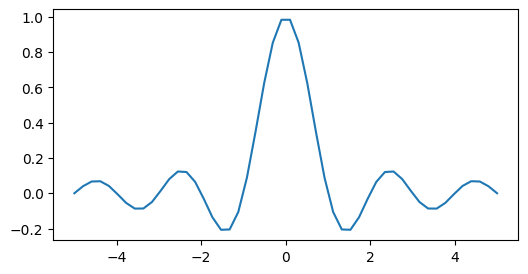nbsphinx¶
nbsphinx is a Sphinx extension that provides a source parser for *.ipynb files.
Documentation: https://nbsphinx.readthedocs.io/
Source Code: https://github.com/spatialaudio/nbsphinx
Install¶
pip install nbsphinx
Then, add the extension to your conf.py:
extensions = [
# ...
"nbsphinx",
]
Examples¶
Here are some examples to show how nbsphinx rendering ipynb files.
Code, Output, Streams¶
An empty code cell:
[ ]:
Two empty lines:
[ ]:
Leading/trailing empty lines:
[1]:
# 2 empty lines before, 1 after
A simple output:
[2]:
6 * 7
[2]:
42
The standard output stream:
[3]:
print('Hello, world!')
Hello, world!
Normal output + standard output
[4]:
print('Hello, world!')
6 * 7
Hello, world!
[4]:
42
The standard error stream is highlighted and displayed just below the code cell. The standard output stream comes afterwards (with no special highlighting). Finally, the “normal” output is displayed.
[5]:
import sys
print("I'll appear on the standard error stream", file=sys.stderr)
print("I'll appear on the standard output stream")
"I'm the 'normal' output"
I'll appear on the standard output stream
I'll appear on the standard error stream
[5]:
"I'm the 'normal' output"
Note
Using the IPython kernel, the order is actually mixed up, see https://github.com/ipython/ipykernel/issues/280.
Math¶
[6]:
from IPython.display import Math
eq = Math(r'\int\limits_{-\infty}^\infty f(x) \delta(x - x_0) dx = f(x_0)')
eq
[6]:
[7]:
display(eq)
[8]:
from IPython.display import Latex
Latex(r'This is a \LaTeX{} equation: $a^2 + b^2 = c^2$')
[8]:
[9]:
%%latex
\begin{equation}
\int\limits_{-\infty}^\infty f(x) \delta(x - x_0) dx = f(x_0)
\end{equation}
matplotlib¶
[10]:
import matplotlib.pyplot as plt
import numpy as np
fig, ax = plt.subplots(figsize=[6, 3])
x = np.linspace(-5, 5, 50)
ax.plot(x, np.sinc(x));

YouTube Videos¶
[11]:
from IPython.display import YouTubeVideo
YouTubeVideo('9_OIs49m56E')
[11]:
Tables¶
[12]:
import pandas as pd
data = [[1, 2], [3, 4]]
pd.DataFrame(data, columns=['Foo', 'Bar'])
[12]:
| Foo | Bar | |
|---|---|---|
| 0 | 1 | 2 |
| 1 | 3 | 4 |
ANSI Colors¶
The standard output and standard error streams may contain ANSI escape sequences to change the text and background colors.
[13]:
print('BEWARE: \x1b[1;33;41mugly colors\x1b[m!', file=sys.stderr)
print('AB\x1b[43mCD\x1b[35mEF\x1b[1mGH\x1b[4mIJ\x1b[7m'
'KL\x1b[49mMN\x1b[39mOP\x1b[22mQR\x1b[24mST\x1b[27mUV')
ABCDEFGHIJKLMNOPQRSTUV
BEWARE: ugly colors!
[14]:
text = ' XYZ '
formatstring = '\x1b[{}m' + text + '\x1b[m'
print(' ' * 6 + ' ' * len(text) +
''.join('{:^{}}'.format(bg, len(text)) for bg in range(40, 48)))
for fg in range(30, 38):
for bold in False, True:
fg_code = ('1;' if bold else '') + str(fg)
print(' {:>4} '.format(fg_code) + formatstring.format(fg_code) +
''.join(formatstring.format(fg_code + ';' + str(bg))
for bg in range(40, 48)))
40 41 42 43 44 45 46 47
30 XYZ XYZ XYZ XYZ XYZ XYZ XYZ XYZ XYZ
1;30 XYZ XYZ XYZ XYZ XYZ XYZ XYZ XYZ XYZ
31 XYZ XYZ XYZ XYZ XYZ XYZ XYZ XYZ XYZ
1;31 XYZ XYZ XYZ XYZ XYZ XYZ XYZ XYZ XYZ
32 XYZ XYZ XYZ XYZ XYZ XYZ XYZ XYZ XYZ
1;32 XYZ XYZ XYZ XYZ XYZ XYZ XYZ XYZ XYZ
33 XYZ XYZ XYZ XYZ XYZ XYZ XYZ XYZ XYZ
1;33 XYZ XYZ XYZ XYZ XYZ XYZ XYZ XYZ XYZ
34 XYZ XYZ XYZ XYZ XYZ XYZ XYZ XYZ XYZ
1;34 XYZ XYZ XYZ XYZ XYZ XYZ XYZ XYZ XYZ
35 XYZ XYZ XYZ XYZ XYZ XYZ XYZ XYZ XYZ
1;35 XYZ XYZ XYZ XYZ XYZ XYZ XYZ XYZ XYZ
36 XYZ XYZ XYZ XYZ XYZ XYZ XYZ XYZ XYZ
1;36 XYZ XYZ XYZ XYZ XYZ XYZ XYZ XYZ XYZ
37 XYZ XYZ XYZ XYZ XYZ XYZ XYZ XYZ XYZ
1;37 XYZ XYZ XYZ XYZ XYZ XYZ XYZ XYZ XYZ
[15]:
formatstring = '\x1b[38;5;{0};48;5;{0}mX\x1b[1mX\x1b[m'
print(' + ' + ''.join('{:2}'.format(i) for i in range(36)))
print(' 0 ' + ''.join(formatstring.format(i) for i in range(16)))
for i in range(7):
i = i * 36 + 16
print('{:3} '.format(i) + ''.join(formatstring.format(i + j)
for j in range(36) if i + j < 256))
+ 0 1 2 3 4 5 6 7 8 91011121314151617181920212223242526272829303132333435
0 XXXXXXXXXXXXXXXXXXXXXXXXXXXXXXXX
16 XXXXXXXXXXXXXXXXXXXXXXXXXXXXXXXXXXXXXXXXXXXXXXXXXXXXXXXXXXXXXXXXXXXXXXXX
52 XXXXXXXXXXXXXXXXXXXXXXXXXXXXXXXXXXXXXXXXXXXXXXXXXXXXXXXXXXXXXXXXXXXXXXXX
88 XXXXXXXXXXXXXXXXXXXXXXXXXXXXXXXXXXXXXXXXXXXXXXXXXXXXXXXXXXXXXXXXXXXXXXXX
124 XXXXXXXXXXXXXXXXXXXXXXXXXXXXXXXXXXXXXXXXXXXXXXXXXXXXXXXXXXXXXXXXXXXXXXXX
160 XXXXXXXXXXXXXXXXXXXXXXXXXXXXXXXXXXXXXXXXXXXXXXXXXXXXXXXXXXXXXXXXXXXXXXXX
196 XXXXXXXXXXXXXXXXXXXXXXXXXXXXXXXXXXXXXXXXXXXXXXXXXXXXXXXXXXXXXXXXXXXXXXXX
232 XXXXXXXXXXXXXXXXXXXXXXXXXXXXXXXXXXXXXXXXXXXXXXXX
[16]:
start = 255, 0, 0
end = 0, 0, 255
length = 79
out = []
for i in range(length):
rgb = [start[c] + int(i * (end[c] - start[c]) / length) for c in range(3)]
out.append('\x1b['
'38;2;{rgb[2]};{rgb[1]};{rgb[0]};'
'48;2;{rgb[0]};{rgb[1]};{rgb[2]}mX\x1b[m'.format(rgb=rgb))
print(''.join(out))
XXXXXXXXXXXXXXXXXXXXXXXXXXXXXXXXXXXXXXXXXXXXXXXXXXXXXXXXXXXXXXXXXXXXXXXXXXXXXXX
Hint
This documentation itself is written in .ipynb. To view the source code,
click the Edit this page link on the right sidebar.